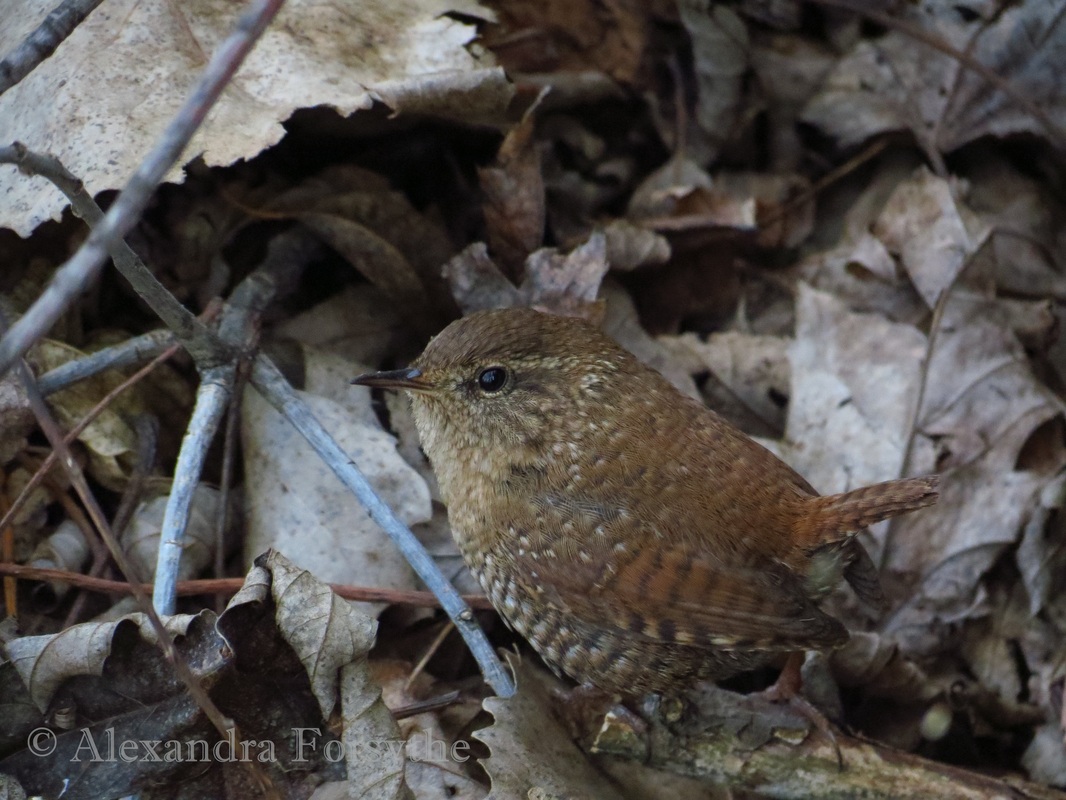
The tiny and adorable Winter Wren looks like a tiny brown ball of fluff with a very short tail that usually sticks straight up in the air. It is probably best known for what naturalist John Burroughs described as its “vibrating tongue of silver”. Its beautifully complex song is a cheerful mix with trills and twitters and it is quite high-pitched averaging around 5,500 hertz. There can be over 100 notes in a single Winter Wren’s 8-second song! Even when a recording of the song is slowed down it is hard to count all of the notes. Gram for gram, the Winter Wren sings more powerfully than a rooster; the wren uses ten times as much power to deliver its song than a rooster does!
Winter Wrens, as their name suggests, will spend winter in Indiana and as far south as the Gulf Coast. They are often found near streams in brushy areas. The Winter Wren was split into three separate species in 2010: the Winter Wren and the Pacific Wren, both of which can be found commonly in North America, and the Eurasian Wren of the Old World. The Pacific Wren’s song is longer but not as musical as that of a Winter Wren. Where their ranges cross, male Winter and Pacific Wrens will fight over territory, but the females of each species will only choose mates from their own species.
The uplifting song has the power to cheer us on a dreary winter’s day. Lynn Sprague said it best in “On Hearing a Winter Wren Sing in Winter”:
When wintry winds through woodlands blow
And naked tree-tops shake and shiver;
While all the paths were bound in snow,
And thick ice chains the merry river,
One little feathered denizen,
A plump and nut-brown winter wren,
Sings of spring-time even there
—Tsip-twis-ch-e-e-e cheerily-cheerily-dare--
Who could listen and despair?
Charmed with the sweetness of his strain.
My heart found cheer in winters bluster;
The leafless wood was fair again,
Its ice-gems sparkled with new luster.
The tiny, trembling, tinkling throat
Poured forth despairs sure antidote,
No leafy June hears sweeter note
— Tsip-twis-ch-e-e-e cheerily-cheerily-dare --
The essence of unspoken prayer.
Winter Wrens, as their name suggests, will spend winter in Indiana and as far south as the Gulf Coast. They are often found near streams in brushy areas. The Winter Wren was split into three separate species in 2010: the Winter Wren and the Pacific Wren, both of which can be found commonly in North America, and the Eurasian Wren of the Old World. The Pacific Wren’s song is longer but not as musical as that of a Winter Wren. Where their ranges cross, male Winter and Pacific Wrens will fight over territory, but the females of each species will only choose mates from their own species.
The uplifting song has the power to cheer us on a dreary winter’s day. Lynn Sprague said it best in “On Hearing a Winter Wren Sing in Winter”:
When wintry winds through woodlands blow
And naked tree-tops shake and shiver;
While all the paths were bound in snow,
And thick ice chains the merry river,
One little feathered denizen,
A plump and nut-brown winter wren,
Sings of spring-time even there
—Tsip-twis-ch-e-e-e cheerily-cheerily-dare--
Who could listen and despair?
Charmed with the sweetness of his strain.
My heart found cheer in winters bluster;
The leafless wood was fair again,
Its ice-gems sparkled with new luster.
The tiny, trembling, tinkling throat
Poured forth despairs sure antidote,
No leafy June hears sweeter note
— Tsip-twis-ch-e-e-e cheerily-cheerily-dare --
The essence of unspoken prayer.
 RSS Feed
RSS Feed
